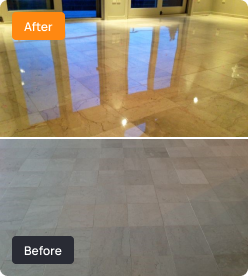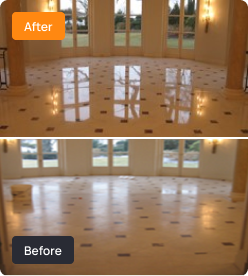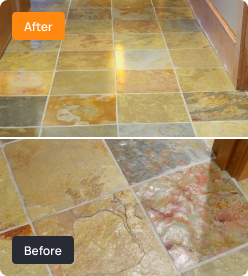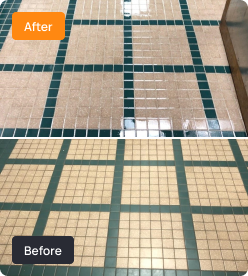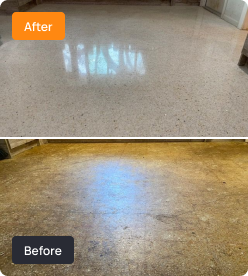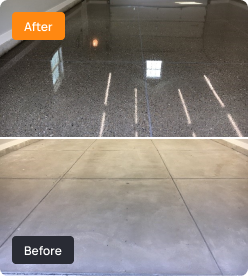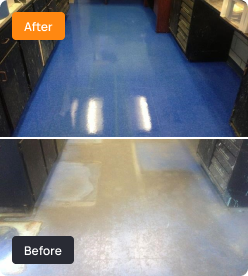How to Extend the Life of Granite Countertops and Floors with Professional Cleaning
Want to know how to get your granite countertops or granite floors cleaned with professional help? You have arrived at the right place. Granite is one of the most successful kitchen countertops surfaces due to its acid resistance, hardness, durability. However, granite does have one minor flaw. What’s the One Major Flaw of Granite? […]
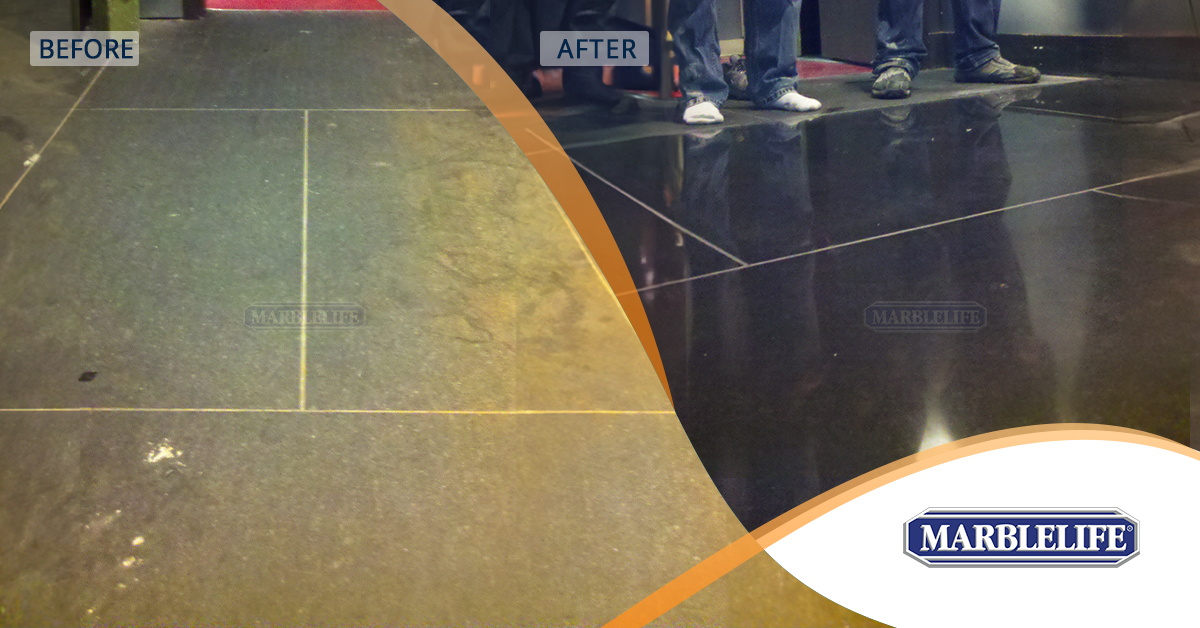

Want to know how to get your granite countertops or granite floors cleaned with professional help? You have arrived at the right place.
Granite is one of the most successful kitchen countertops surfaces due to its acid resistance, hardness, durability. However, granite does have one minor flaw.
What’s the One Major Flaw of Granite?
Granite is porous. Perhaps not as porous as marble or grout, but porous enough to look bad after absorbing kitchen grease, oil, cleaners and spills after years of use.
Note we mentioned “cleaners”. Yes, the very act of cleaning can result in staining IF the surface is not properly sealed. Sealing granite plugs its primary source of potential failure.
So, when cleaning itself can hurt granite surface, how can we clean it the right way? This question becomes even more pressing when you have granite surfaces in various areas of your home.
The answer is more complex than one might hope. Different areas of usage, varying styles, and the diverse characteristics of granite call for specific cleaning and maintenance techniques.
This article covers everything you need to know granite itself, granite countertops, granite floor, and cleaning tips. So, let’s get started.
Know Your Granite: Formation, Structure, and Cleaning
Granite is admired for its toughness (hardness and durability) and visual appeal. Formed deep within the Earth from molten magma that gradually cools, this robust rock combines minerals such as quartz, feldspar, and mica.
This unique composition grants granite its durability, distinctive shimmer, and diverse colors. Every piece of granite is unique, with its own patterns and shades, making it a work of art in your home and office.
It has made it the show surface on Egyptian obelisks and monuments – when they really wanted them to last.
Liquids are the primary weak point for granite counters, while foot traffic particularly in front of stairs and elevator doors for granite floors.
But, even though it’s tough, granite can soak up liquids. Granite has tiny holes or pores, which can adsorb liquids and alter the appearance of the surface to create a stain.
Granite Countertops and Granite Surface Cleaning Tips
Stains are a nuisance to remove, as one cannot simply wipe them up as they are not ON the surface but rather IN the surface.
For this reason, it is recommended to:
- Dab versus wipe when cleaning up a spill on granite surface, so as to not allow it to spread more than necessary.
- If you do have a stain event, and you see the surface is darker in one area, use a paper towel to blot the area so as to draw out as much of the liquid as possible before it dries.
- Once it dries this becomes more difficult as one now has to re-solvate the foreign staining matter before seeking to draw it out, and doing so without spreading the stain further. Far better to have sealed the surface, so as to keep the spill ON the surface where it is easier to clean.
- If blotting fails to draw it out, or it has stained, one will need to poultice out the stain. If you know what the culprit is, that makes the job easier. if not, you need to try a variety of potential solvents to dissolve the foreign material and the draw it from the stone.
- You need to be careful as the stain can move once solvated and spread. The author speaks from experience here having taken a 2 inch wide rust stain and spread it across 5 feet before realizing what was happening and how to prevent it from moving wider and spreading, versus coming out.
- When trying to get a stain OUT, first soak the surrounding areas with clean water so as to fill up surrounding pores and preventing the stain from moving sideways. Then apply a pile of paper towels or absorbent material with a solvating liquid associated with the stain. (CALL MARBLELIFE for a recommendation as we can provide you one of 76 different remedies based on the material that has soiled the surface). Water (for water soluble stains) or a degreaser (MARBLELIFE CLEANER) for grease and oil based stains can be used here.
- Soak a pile of 5 paper towels and apply to stain, then allow to dry. The liquid will first enter the stone going from soaked towel to dry stone.
- Once it reaches equilibrium the paper towel will dry waster than the stone and wick the liquid back up from the stone. The hope is that it brings with it the stain. One may need to repeat this several times, as the stain will seak to reach equilibrium between the porous towel and the stone.
- If you see the stain has lightened, OR the paper towel is stained we are successfully removing the material. Repeat. Once satisfied the stain has been removed, HALT THIS MADNESS and SEAL the counter.
Why We Seal Granite: A Simple Guide to Granite Care
Sealing your stone makes future cleaning easier. Stains are tough to remove. Daily cleaning on a sealed surface is easy, as everything remains ON the surface versus IN the surface.
Keeping your granite looking good needs some help – that’s where professional sealing comes in. In this part, we’ll talk about why we seal granite, how it works, and the benefits it offers.
The Purpose of Sealing
Granite has small holes that can soak up liquids if it’s not protected. This can cause stains and damage over time. Sealing is like giving your granite a protective coat. It fills in the small holes and stops liquids from soaking in.
Why Seal Your Granite Professionally?
- Professional sealing makes your granite resist stains. This means spills and oils won’t leave ugly darkened rings and marks.
- When granite is sealed, it’s easier to clean. Dirt and liquids can’t soak in and stick to the stone.
- Granite that’s sealed professionally can keep its shine and beauty for years, even if you use it every day.
Sealing is a simple process. Here is quick process you can follow.
Granite Surface Sealing Tips
- Using a penetrating sealer such as MARBLELIFE STONE SEALER, soak the surface, allow it to set for 2 to 3 minutes to penetrate and then wipe off the excess material and allow it to set for 24 hours.
- We only want material IN the stone not ON the stone. Do not allow this to set for more than 15 minutes, else the surface will begin to cure and become sticky which would require professional service to remove.
- If this does happen try and re-apply the sealant and wipe off immediately. The solvent in the sealer may be able to dissolve the partially cured sealer and allow you to wipe it off. Repeat sealing annually to ensure that any areas that have become unsealed are resealed.
- Acids can remove a surface seal, if allowed to dwell on the surface. As all fruit juices are acidic, as is tomato juice, sodas, coffee and tea avoiding acids is not easy.
That said, never fear, if you spills, simply blot up the spill. Degrading the seal takes time. As such, promptly cleaning up a spill will extend the life of your seal and the stain-free appearance of our granite counters.
While granite can take the heat, putting a hot pan directly on it from the stove could cause it to crack due to a quick temperature change.
If you have ever seen framed-granite, know that they is created by applying a 700 F torch to burst the quartz. This is a wonderful anti-slip floor surface, but not a great look on your counter.
So, it’s always smart to use a trivet or hot pad. And while it can take a lot, dropping something heavy on it could cause it to chip or break.
Granite floors are exceptionally wear resistant, making them the ideal balance between elegance and durability. It is surprising that more people do not make use of them.
Marble remains the measure of elegance due to its veining and patterning, but granite is truly the superior balance. it takes a LOT of foot traffic to require a restoration service with a granite surface.
When it does, which is usually in a hotel elevator, these surfaces can be restored to the prior glory by a professional craftsman, such as MARBLELIFE.
Cleaning Granite the Right Way: Simple Steps for Everyday Care
It’s important to follow a regular cleaning routine to keep your granite surfaces looking their best. Here’s a simple approach that even a busy homeowner can manage:
1. Address Spills Promptly
Granite is porous, meaning it can absorb liquids and potentially stain. So, whenever a spill happens, act fast! Use a soft cloth to blot the spill up, not spreading the liquid into the stone’s pores.
2. Wipe Regularly
A daily wipe-down with a non-acidic degreasing cleaner helps keep your granite surfaces looking fresh and smudge-free without damaging your acid sensitive penetrating seals.
Using a soft, damp cloth, gently remove dust and light debris. This easy habit can make a noticeable difference in maintaining your granite’s shine.
3. Choose the Right Cleaner
Not just any cleaner will do when it comes to granite. Some cleaning agents can be too harsh, causing damage over time. What does that mean?
Acidic cleaners will not damage the granite, but they will damage the granite’s seal making it susceptible to staining. You will hear people state that today’s granite does not need to be sealed.
That is not accurate. Most granite surfaces are now resinated, which makes the slab more flexible and easier to ship around the world.
This requires a polyester resin to be SUCKED through the granite slab via those open pores we discussed sealing. The issue is that only the pores that can all the way through the stone get sealed.
Those that only go partially through remain open and stainable. As such, the reason they do not promote this process as sealing the stone, is because there remain open pores.
Do not use a glass cleaner or an all purpose cleaner, as these contain wax which will build-up over time, hiding the granite’s polished luster, and trapping dirt between the wax layers.
Eventually this results in the need for a professional cleaning to restore the surface once again.
Do not use clean-and-polish or scented-cleaners as these cleaners are designed to leave oils on the surface, which is what provides the scent and the shine.
Kind of counter intuitive that we are leaving oils by a product that is supposed to be removing grease and oils from the surface.
These are more marketing hype than performance, and seek to leverage the uniquely American perception that SHINY means CLEAN and CLEAN should be SHINY.
In truth, clean is the absence of foreign material such as dirt and oil from the surface. Using a cleaner designed for granite is important to avoid these issues.
For a simple and effective way to keep your granite surfaces looking their best, consider MARBLELIFE’s Granite Countertop Cleaner.
The product is specifically designed to safely remove grease, oils, and other residues from granite surfaces. Formulated to be easy to use, highly effective, and to accomplish its goal without the use of acids, oils, waxes or unnecessary scents (oils).
Avoid cleaning systems that recommend use of a daily polish. The daily polish is not a polish but rather either a wax or oil that temporarily fills in scratches, and low spots to help light reflect and appear shiny.
The issue is that these oils become sticky and the waxes trap dirt and build-up until they eventually need a professional cleaning. This is marketing hype at its worse.
If your surface is not providing the gloss or shine you would like it is either blocked with build-up or has been worn. As it is unlikely you are walking on your counters, it is not likely wear, but build-up.
Call MARBLELIFE to free your counter of these build-up issues and restore your surfaces natural sheen.
If you MUST have an immediate boost in sheen, you can use a conditioner. This is NOT a polish. It is a short-term fix designed to boost the shine of the surface by filling in low spots to allow light to bounce true and deliver a temporary gloss.
If this is needed, you should consider a service, as there is a good chance that the surface is blocked and one could achieve the desired appearance with a service.
To add that extra shine to your granite surfaces, consider using MARBLELIFE’s Granite Countertop Gloss Conditioner.
This product revives the natural beauty of your granite without the need for harsh chemicals. There are times when time does not allow for a service, at which point this product fills the bill.
4. Apply Cleaner Properly
When using your cleaner, spray it onto the granite surface and wipe it with a soft cloth or sponge. We prefer microfiber as it offers maximum surface area to adsorb dirt and dust making it easier to lift and remove from the surface.
Be sure to clean your kitchen clothes (and mops) in order to flush what has been picked up and removed from the surface, so as not to return this material with the next wiping. Ever visited a restaurant, and felt your feet slip across the floor?
This happens when the mop used to clean-up a greasy situation in the kitchen is then used on the main floor effectively transferring what was being removed from the floor in one area to another.
In a restaurant the main dining area mop should be separate from the kitchen mop, and the mop heads should be changed out daily and laundered to maintain its ability to pick up without transferring.
5. Rinse and Dry Thoroughly
After you’ve cleaned the surface, rinse it well with water to remove any leftover cleaner. Then, dry it using a soft, clean cloth. This helps prevent water spots from forming and ensures your granite surface is clean and shiny.
More spots, are not a foregone conclusion, unless you have hard water, which means it contains calcium carbonate, which will precipitate out when the water evaporates leaving white spots. if this occurs call MARBLELIFE.
We can remove these as well. Beware hard water stain removers as these are acidic cleaners that will also remove counter seals and grout seals opening the surface up to staining issues.
The Risks of Abrasive Cleaning
Taking care of your granite surfaces is a lot like caring for a prized cashmere sweater. Both investments deserve thoughtful handling to keep them looking their best for years.
Just as you wouldn’t toss your treasured sweater into a rough washing cycle, you shouldn’t subject your granite to abrasive cleaning tools. Rough brushes and scouring pads can leave minute scratches on your granite surface.
These will definitely remove your shine. if you feel there is a need for an abrasive call MARBLELIFE for a FREE CONSULATION. We can generally diagnose the problem and provide a less damaging path forward.
MARBLELIFE SOAP AND SCUM REMOVER is formulated to assist in removing stubborn build-up without damaging the surface.
It employs an engineered abrasive that is harder than most build-up but softer than the stone surface and will breakdown and disintegrate when it rubs against granite.
Formulated as a shower cleaner to remove soap scum one can feel and hear it work, and when it has succeeded in completing the process.
So, how do you treat your granite with the gentleness it deserves?
- RIGHT CLEANING METHOD – Start by using soft cleaning tools, like microfiber cloths. These cloths are like the ‘delicate cycle’ for your granite, lifting away dust and dirt without scratching the surface.
- RIGHT CLEANER – Next, just like you’d select a mild detergent for your sweater, choose a gentle cleaner on granite. Some cleaning products can be harsh and damaging, so opt for a product specifically designed for granite. This cleaner should effectively remove oils and other residues without being too abrasive.
- Regular cleaning is also key to maintaining your granite’s luster. It’s akin to immediately addressing a spill on your sweater to prevent a stain. Since granite can absorb liquids, cleaning up spills as quickly as possible is crucial.
WHEN IN DOUBT ASK? FREE CONSULTATIONS can save you time, money and heartache
Lastly, think about seeking out professional cleaning services. Just as you’d occasionally send your cashmere sweater for professional dry cleaning to maintain its quality, your granite surfaces can benefit from expert care.
Regular professional cleaning can ensure the longevity and beauty of your granite, keeping it as stunning as the day it was installed.
Making Granite Look Great with MARBLELIFE
If you want to keep your granite surfaces looking their best, MARBLELIFE is a great choice. We offer a special Granite Sealing service. Here’s why it’s good:
- The MARBLELIFE team will look over your granite surfaces to spot any problems, like cracks or stains. We fix these issues before starting the sealing process.
- Safe for everyone: The team uses only high-quality sealers that are stone and family-safe.
- The team is skilled at applying the sealer so that every part of your granite surface gets covered, and all excess material is removed so as to avoid a sticky surface (which only happens if excess material is not removed).
- The seal on granite can wear off over time. Our team will guide you on when to get your granite surfaces resealed so they continue to stay protected.
Keep Your Granite Looking Its Best – Call MARBLELIFE
Your granite surfaces make your home look beautiful. To keep them that way, getting them sealed regularly is important. Trust MARBLELIFE to do an excellent job.
Get in touch with MARBLELIFE today and give your granite the care it needs.


